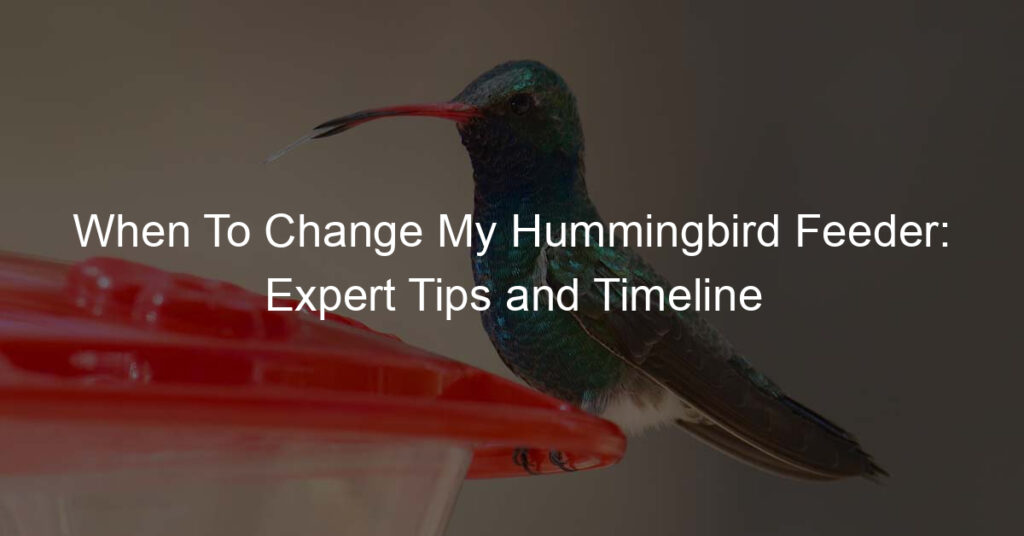Introduction to Hummingbird Feeder Maintenance
Maintaining a hummingbird feeder is not just about providing a source of food for these beautiful creatures. It’s about creating a safe and healthy environment for them to thrive. This article will guide you through the importance of regular maintenance and its impact on hummingbird health and habitat.
Importance of Regular Maintenance
Regular maintenance of your hummingbird feeder is crucial for several reasons. Firstly, it ensures that the feeder is always filled with fresh nectar, which is vital for the hummingbirds’ health. Secondly, a well-maintained feeder is less likely to attract pests like ants and bees, which can deter hummingbirds from visiting. Lastly, regular cleaning prevents the growth of mold and bacteria, which can be harmful to hummingbirds.
Impact on Hummingbird Health and Habitat
The health of hummingbirds is directly linked to the condition of their habitat, including the feeders they visit. A poorly maintained feeder can lead to disease spread among hummingbird populations, affecting their health and survival. On the other hand, a well-maintained feeder can attract more hummingbirds and contribute to the overall health of the local hummingbird population. It can also encourage hummingbirds to establish a habitat near your home, providing you with the joy of their regular visits.
Understanding the importance of hummingbird feeder maintenance and its impact on hummingbird health and habitat is the first step towards becoming a responsible hummingbird feeder owner. The following sections will provide you with more detailed information on how to properly maintain your hummingbird feeder.
Understanding Your Hummingbird Feeder
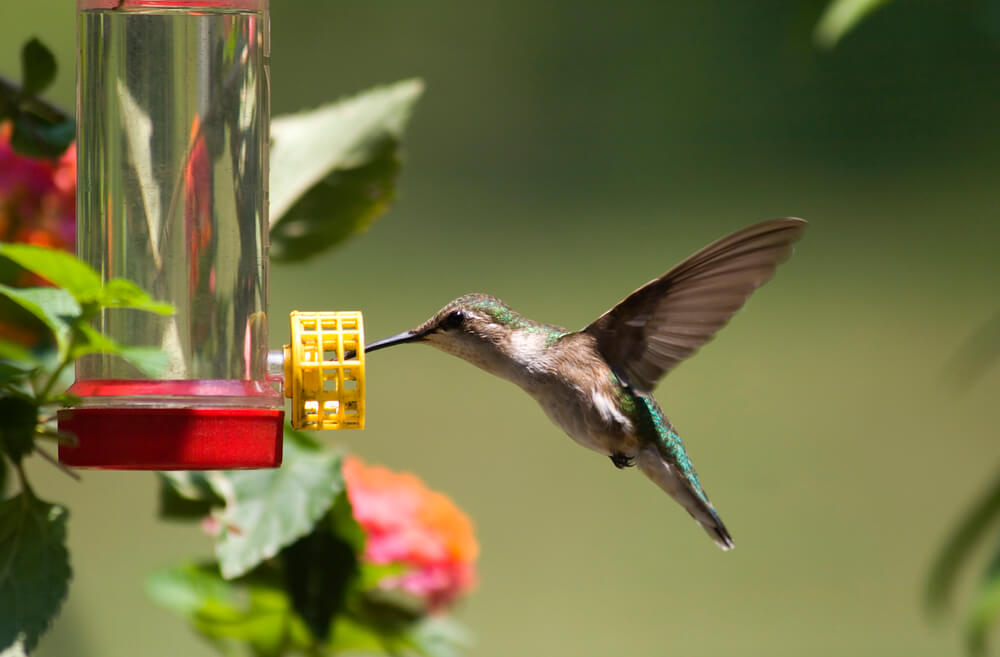
Hummingbird feeders are a fantastic way to attract these beautiful, tiny birds to your garden. But did you know there are different types of feeders? Understanding the type of hummingbird feeder you have can help you provide the best care for your feathered visitors.
Types of Hummingbird Feeders
There are three main types of hummingbird feeders. Each one has its own unique features and benefits. Let’s take a closer look at each type:
- Tube Feeders: Tube feeders are a popular choice for many bird enthusiasts. They are designed with a long, slender tube that holds the nectar. Hummingbirds can easily access the nectar through small feeding ports at the bottom of the tube. This design helps to keep the nectar fresh and clean. You can learn more about tube feeders here.
- Dish Feeders: Dish feeders, also known as saucer feeders, are flat and shallow. They hold the nectar in a dish, making it easy for the hummingbirds to feed. These feeders are easy to clean and refill, but they may need to be refilled more often as they typically hold less nectar than tube feeders. More information about dish feeders can be found here.
- Window Feeders: Window feeders are designed to attach directly to your window. This allows you to enjoy close-up views of hummingbirds as they feed. These feeders are usually smaller and hold less nectar, so they may need to be refilled more frequently. Learn more about window feeders here.
Understanding the type of hummingbird feeder you have will help you provide the best care for your feathered visitors. Whether you have a tube, dish, or window feeder, each type offers a unique way to enjoy these beautiful birds.
Materials and Construction
Hummingbird feeders come in a variety of materials, each with its own unique benefits and considerations. Let’s explore the three most common types: plastic, glass, and metal feeders.
1. Plastic Feeders
Plastic feeders are a popular choice due to their lightweight and affordable nature. They are easy to handle and clean, making them a great option for beginners. However, they may not be as durable as other materials and can fade or crack over time when exposed to the elements. Wikipedia provides a comprehensive guide on the different types of bird feeders, including plastic ones.
2. Glass Feeders
Glass hummingbird feeders are often praised for their aesthetic appeal. They come in a variety of beautiful designs and colors that can add a touch of elegance to your garden. Glass is also more durable than plastic and doesn’t fade over time. However, they can be more fragile and require careful handling.
3. Metal Feeders
Metal feeders are the most durable of all. They can withstand harsh weather conditions and are resistant to squirrel damage. They are also easy to clean and maintain. However, they can be more expensive and heavier than plastic or glass feeders.
In conclusion, the material of your hummingbird feeder will largely depend on your personal preferences, budget, and the specific needs of your garden environment. Regardless of the material, regular cleaning and maintenance are essential to keep your feathered friends healthy and happy.
Changing Your Hummingbird Feeder
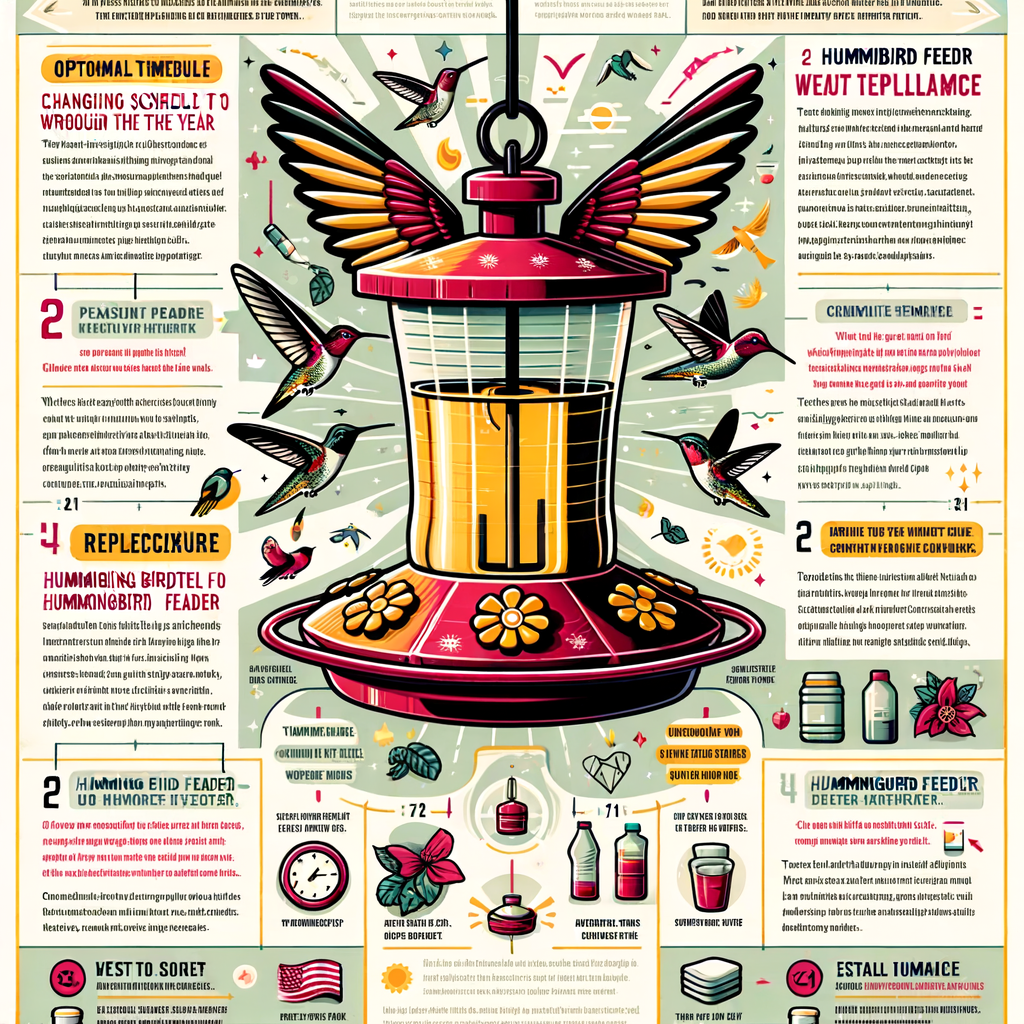
Changing your hummingbird feeder is an important part of maintaining a healthy environment for these delightful birds. Knowing when and how to change the feeder can make a big difference in attracting and keeping hummingbirds in your yard.
Best Time to Change Hummingbird Feeder
There are several factors to consider when deciding the best time to change your hummingbird feeder. These include seasonal considerations, weather conditions, and hummingbird feeding patterns.
Seasonal considerations: Hummingbirds typically migrate in the spring and fall. Therefore, it’s best to change your feeder just before these seasons begin. This ensures that the feeder is fresh and ready for the hummingbirds when they arrive. For more information on hummingbird migration patterns, visit the Wikipedia page on Hummingbirds.
Weather conditions: Weather conditions can affect the nectar in your hummingbird feeder. In hot weather, the nectar can ferment quickly, which can be harmful to hummingbirds. Therefore, it’s best to change your feeder more frequently during hot weather. In colder weather, the nectar can freeze, making it inaccessible to the birds. In this case, consider bringing the feeder indoors at night or providing a heated feeder.
Hummingbird feeding patterns: Hummingbirds typically feed several times a day, and they consume a lot of nectar. If you notice that the nectar level in your feeder is decreasing rapidly, it may be time to change the feeder. Also, if you notice fewer hummingbirds visiting your feeder, it could be a sign that the nectar is not fresh, and the feeder needs to be changed.
By paying attention to these factors, you can ensure that your hummingbird feeder is always fresh and appealing to these beautiful birds.
Hummingbird Feeder Schedule
Keeping a hummingbird feeder is a rewarding experience, but it does require a certain level of commitment. To ensure the health and happiness of your feathered visitors, it’s important to follow a regular schedule for cleaning, refilling, and replacing your feeder. Let’s take a closer look at each of these steps.
1. Regular Cleaning and Refilling
Hummingbirds are attracted to clean, fresh nectar, so it’s essential to clean and refill your feeder regularly. A good rule of thumb is to clean your feeder once a week, or more often in hot weather. Use a solution of one part white vinegar to four parts water, and rinse thoroughly. Refill the feeder with fresh nectar, which can be made by dissolving one part sugar in four parts water. Avoid using red dye, as it can be harmful to hummingbirds.
2. Seasonal Replacement
Over time, your hummingbird feeder may become worn or damaged, making it less attractive to hummingbirds and potentially even hazardous. A good practice is to replace your feeder once a year, typically at the beginning of the feeding season in spring. This ensures that your feeder is in top condition when the hummingbirds arrive.
3. Emergency Situations
There may be times when you need to deviate from your regular feeder schedule. For example, if you notice that your feeder has become contaminated with mold or insects, it’s important to clean it immediately. If a hummingbird appears sick or injured, remove the feeder and contact a local wildlife rehabilitator for advice. Always prioritize the health and safety of the hummingbirds over sticking to a strict schedule.
In conclusion, maintaining a regular hummingbird feeder schedule is key to attracting these beautiful birds and ensuring their well-being. By cleaning and refilling your feeder regularly, replacing it annually, and being prepared to handle emergency situations, you can enjoy the company of hummingbirds for years to come.
Hummingbird Feeder Cleaning
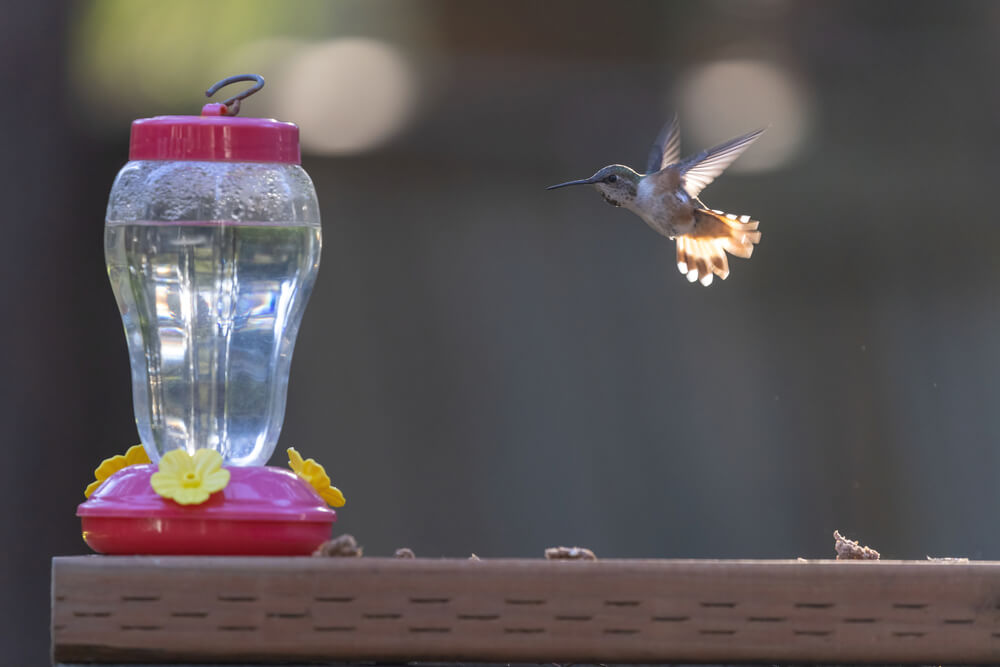
Cleaning your hummingbird feeder is an essential task to ensure the health and safety of your feathered friends. It’s a simple process that requires a few basic tools and materials. Let’s take a look at what you’ll need.
Tools and Materials
The right tools and materials can make the task of cleaning your hummingbird feeder much easier. Here are the basic items you’ll need:
- Brushes and scrubbers: These are crucial for reaching into the nooks and crannies of your feeder. A long, thin brush is perfect for cleaning the feeding ports, while a larger brush can be used for the main reservoir. Some feeders come with their own cleaning brushes, but if yours didn’t, don’t worry. You can find suitable brushes in most pet stores or online.
- Safe cleaning solutions: It’s important to use a cleaning solution that’s safe for hummingbirds. Avoid using harsh chemicals or detergents, as these can be harmful to the birds. A simple solution of one part white vinegar to four parts water is a safe and effective cleaning solution. Rinse thoroughly after cleaning to ensure no residue is left behind.
With these tools and materials, you’ll be well-prepared to keep your hummingbird feeder clean and safe for your avian visitors. Remember, a clean feeder is a healthy feeder!
Cleaning Process
Keeping your hummingbird feeder clean is vital for the health of your feathered friends. The cleaning process is simple and can be broken down into three main steps:
- Disassembling the Feeder
Start by taking apart your hummingbird feeder. Most feeders are designed to be easily disassembled for cleaning. Remove the top, bottom, and any other removable parts. Be sure to keep track of all pieces so you can put them back together correctly.
- Cleaning and Rinsing
Next, clean each part of the feeder. Use a mild, non-toxic cleaning solution and a soft brush to scrub away any residue or mold. Pay special attention to the feeding ports, as these can become clogged with sugar residue. After cleaning, rinse each part thoroughly with warm water to remove any remaining cleaning solution.
- Drying and Reassembling
Once all parts are clean, allow them to air dry completely. This helps prevent the growth of mold and bacteria. When all parts are dry, reassemble the feeder. Make sure all pieces are securely in place before refilling with nectar.
Regular cleaning of your hummingbird feeder not only ensures the health of your hummingbirds but also extends the lifespan of your feeder. Remember, a clean feeder is a happy feeder!
Hummingbird Feeder Care
Hummingbird feeders are a wonderful way to attract these beautiful birds to your garden. However, they require careful maintenance to keep them safe and healthy for the birds. One of the most important aspects of this care involves preventing the growth of mold and bacteria.
Preventing Mold and Bacteria
Mold and bacteria can pose a serious threat to hummingbirds. These harmful organisms can grow in the sugar water solution that is used to fill the feeder, especially if it is not cleaned and stored properly. Here are some key steps you can take to prevent this problem:
- Regular cleaning: It’s crucial to clean your hummingbird feeder at least once a week. Use hot water and a mild detergent, making sure to rinse thoroughly to remove any soap residue. For a more thorough cleaning, you can also use a solution of one part white vinegar to four parts water. This will help to kill any mold or bacteria that may be present.
- Proper storage: When not in use, store your hummingbird feeder in a cool, dry place. This will help to prevent the growth of mold and bacteria. If you live in a humid climate, you may want to consider storing your feeder in the refrigerator. Just be sure to let it come to room temperature before refilling and hanging it back up.
By following these simple steps, you can help to ensure that your hummingbird feeder remains a safe and inviting place for these beautiful birds. Remember, a clean feeder is a healthy feeder!
Protecting from Pests
One of the challenges of maintaining a hummingbird feeder is protecting it from pests. These pests can range from small insects like ants and bees to larger animals like squirrels and birds. Let’s discuss how to protect your feeder from these common pests.
Ants and Bees
Ants and bees are attracted to the sweet nectar in hummingbird feeders. They can become a nuisance and even deter hummingbirds from visiting your feeder. To prevent ants and bees from invading your feeder, consider using an ant moat or bee guards. An ant moat is a device that hangs above the feeder and is filled with water, creating a barrier that ants cannot cross. Bee guards are small plastic grids that cover the feeding ports, preventing bees from accessing the nectar while still allowing hummingbirds to feed.
Squirrels and Larger Birds
Squirrels and larger birds can also pose a problem as they can consume large amounts of nectar and even damage the feeder. To deter these pests, consider using a squirrel baffle and placing your feeder in a location that’s difficult for larger birds to access. A squirrel baffle is a device that can be attached to the feeder pole to prevent squirrels from climbing up to the feeder.
Remember, the goal is to create a safe and welcoming environment for hummingbirds. By taking these steps, you can ensure that your feeder remains a favorite spot for these beautiful birds.
When to Refill Your Hummingbird Feeder
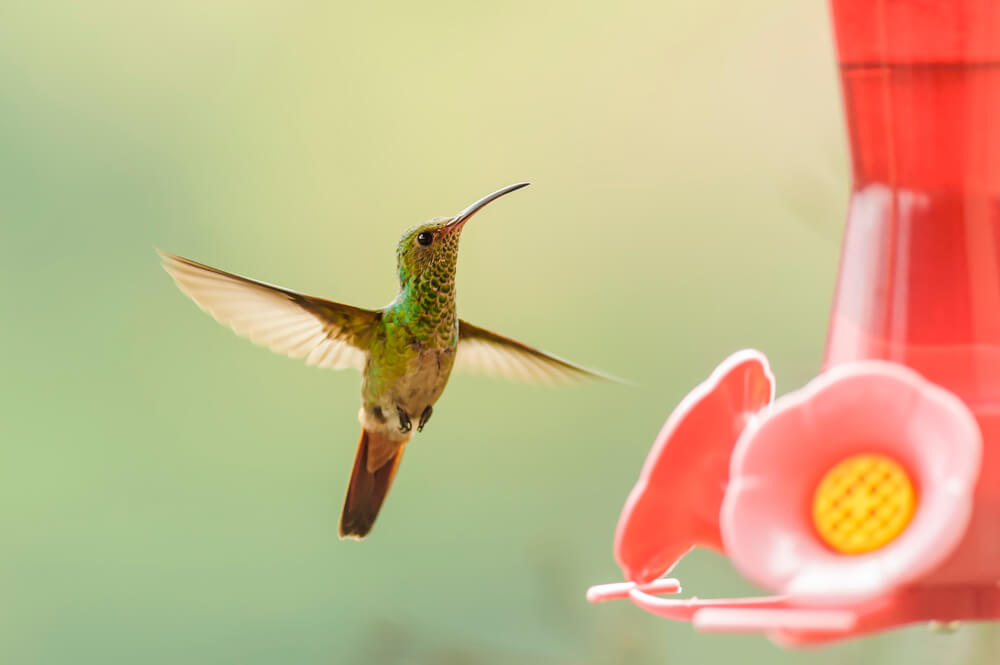
Knowing when to refill your hummingbird feeder is crucial to keep these beautiful creatures visiting your garden. There are two main indicators that it’s time to refill your feeder: signs of low nectar and changes in hummingbird behavior.
Signs of Low Nectar
One of the most obvious signs that it’s time to refill your hummingbird feeder is when the nectar level is low. If you notice that the nectar in your feeder is less than half full, it’s a good idea to refill it. Hummingbirds consume a large amount of nectar each day, so it’s important to keep your feeder well-stocked. If the nectar level is consistently low, the hummingbirds may start looking for other sources of food and stop visiting your feeder.
Hummingbird Behavior
Changes in hummingbird behavior can also indicate that it’s time to refill your feeder. If you see hummingbirds hovering around the feeder but not feeding, or if they are visiting the feeder less frequently, it could be a sign that the nectar level is too low. Hummingbirds are creatures of habit, and if they find that your feeder is consistently empty, they may stop visiting it altogether.
Refilling your hummingbird feeder regularly is not only beneficial for the hummingbirds but also for you. It provides you with the opportunity to observe these fascinating creatures up close. So, keep an eye on the nectar level and the behavior of the hummingbirds to ensure your feeder is always filled with fresh nectar.
Seasonal Hummingbird Feeder Change
As the seasons change, so do the needs of our feathered friends, the hummingbirds. It’s important to adjust your hummingbird feeder care routine accordingly to ensure these beautiful creatures continue to thrive in your garden.
Spring and Summer Care
During the warmer months of spring and summer, hummingbirds are more active and thus, require more attention. Here are a couple of key points to keep in mind:
- Increased feeding: Hummingbirds have a high metabolism and need to feed frequently. In spring and summer, their energy requirements increase due to the active breeding and migration seasons. Therefore, it’s crucial to refill your hummingbird feeders more often. A good practice is to check the feeder daily and refill it as needed. Remember, a consistent food source will keep these birds coming back to your garden.
- Higher maintenance: With increased feeding comes the need for higher maintenance. Regular cleaning of the feeder is essential to prevent the growth of harmful mold and bacteria. A weekly cleaning routine is recommended during these seasons. Use a solution of one part white vinegar to four parts water, rinse thoroughly and let it dry before refilling. This will ensure a safe and healthy feeding environment for the hummingbirds.
By following these simple steps, you can provide a welcoming and nourishing environment for hummingbirds during the spring and summer months. Remember, the key to attracting and keeping these beautiful birds in your garden is consistent care and maintenance of your hummingbird feeders.
Fall and Winter Care
As the seasons change, so do the needs of our feathered friends. During the fall and winter months, hummingbirds migrate to warmer climates. This means that your hummingbird feeder will require a different kind of care. Let’s explore the two main tasks you should focus on during this time.
Reduced feeding
During fall and winter, the number of hummingbirds visiting your feeder will decrease significantly. This is because most hummingbirds migrate to warmer regions where food is abundant. As such, you should reduce the amount of nectar you put in your feeder. Overfilling it can lead to wastage as the nectar may spoil before it’s consumed. A good rule of thumb is to fill the feeder only half-way during these months.
Storage and cleaning
With fewer hummingbirds around, it’s a good time to give your feeder a thorough cleaning. Start by emptying any remaining nectar. Then, use a mild detergent and warm water to clean the feeder, making sure to scrub all corners and crevices. Rinse well to remove all soap residues. Once clean, dry the feeder completely before storing it. This will prevent mold and mildew from developing. Store your feeder in a cool, dry place until spring arrives.
Remember, taking care of your hummingbird feeder during the fall and winter months will ensure it’s ready for use when the hummingbirds return in the spring. It also helps to prolong the lifespan of your feeder, giving you more value for your investment.
Hummingbird Feeder Replacement
Just like any other item in your home, your hummingbird feeder requires attention and occasional replacement. This ensures that your feathered friends continue to enjoy their meals in a safe and clean environment. Let’s discuss the signs of wear and damage and why you might consider upgrading your feeder.
- Signs of wear and damage
Over time, your hummingbird feeder can show signs of wear and tear. These signs might include:
- Cracks or chips in the feeder’s body or feeding ports
- Discoloration or fading due to exposure to sunlight
- Leakages that can waste the nectar and attract ants
- Rust on metal parts, if any
If you notice any of these signs, it’s time to consider a replacement. A damaged feeder can harm hummingbirds and deter them from visiting your garden. It can also lead to wastage of nectar and attract unwanted pests.
- Upgrading your feeder
Upgrading your hummingbird feeder can be a great way to attract more birds and provide them with a safer and more comfortable feeding environment. Here are a few reasons why you might consider an upgrade:
- You want to attract more birds: Larger feeders or those with more feeding ports can accommodate more hummingbirds at a time.
- You want to provide a safer feeding environment: Modern feeders often come with bee guards and ant moats to keep pests away.
- You’re looking for easier maintenance: Some newer models are easier to clean and refill, making your job as a bird feeder easier and more enjoyable.
Remember, the goal is to create a safe and welcoming environment for the hummingbirds. Whether you’re replacing a worn-out feeder or upgrading to a better model, your feathered friends will surely appreciate your efforts.
Hummingbird Feeder Tips
Attracting hummingbirds to your yard can be a rewarding experience. However, it requires more than just hanging a feeder. Here are some tips to help you create an inviting space for these tiny, delightful birds.
Location and Placement
Choosing the right location for your hummingbird feeder is crucial. Hummingbirds prefer areas with a mix of sun and shade, and they appreciate a quiet and safe spot away from predators. Place your feeder at least 4 feet off the ground and within 10-15 feet of a tree or shrub. This gives the birds a place to rest and hide if necessary. Avoid placing your feeder near windows to prevent collisions.
Creating a Hummingbird-Friendly Yard
Creating a hummingbird-friendly yard goes beyond just providing a feeder. Hummingbirds are attracted to a variety of flowering plants, especially those with bright, tubular flowers. Consider planting flowers like bee balm, cardinal flower, or trumpet vine to attract more hummingbirds. Additionally, providing a source of clean water, such as a birdbath or a misting device, can also make your yard more appealing to these birds. Remember, a yard that provides natural food sources, water, and shelter will be most attractive to hummingbirds.
In conclusion, attracting and maintaining a hummingbird population in your yard requires careful consideration of feeder placement and creating a yard that meets their needs. With these tips, you can enjoy the beauty and activity of hummingbirds all season long.

